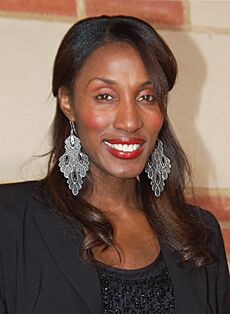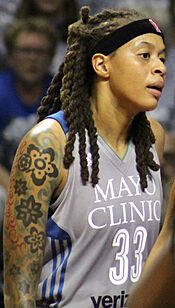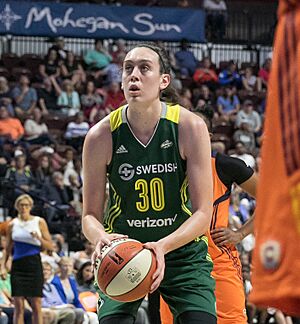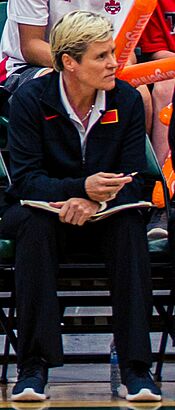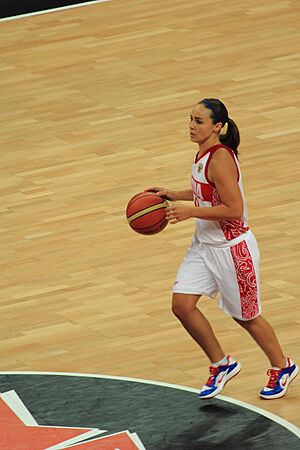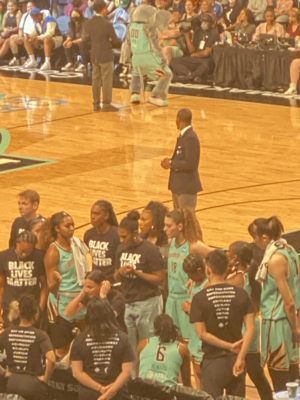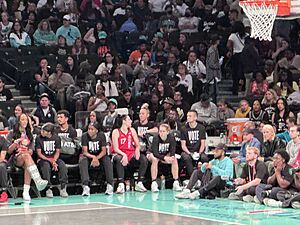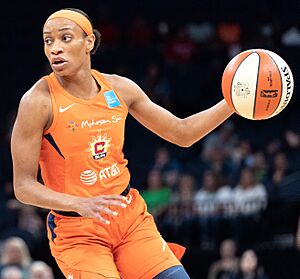Women's National Basketball Association facts for kids
 |
|
| Founded | April 24, 1996 |
|---|---|
| Country | United States |
| Number of teams | 13 (18 by 2030) |
| Domestic cup(s) | Commissioner's Cup |
| Current champions | New York Liberty (1st title) |
| Most championships | Houston Comets Minnesota Lynx Seattle Storm (4 titles each) |
| Commissioner | Cathy Engelbert |
The Women's National Basketball Association (WNBA) is a professional basketball league for women in the United States. It has 13 teams, and by 2030, it plans to have 18 teams. The WNBA's main office is in Midtown Manhattan, New York City.
The WNBA started on April 24, 1996. It was created to be the women's version of the National Basketball Association (NBA). Games officially began in 1997. The regular season runs from May to September, with each team playing 44 games. The top eight teams, no matter which conference they are in, move on to the playoffs. The season ends with the WNBA Finals in October.
A special All-Star Game happens in July, about halfway through the season. The league also has a yearly competition called the Commissioner's Cup. The WNBA is part of USA Basketball (USAB), which is the official group for basketball in the United States.
Contents
- History of the WNBA
- How the League Started (1996–1997)
- Houston's Dominance and League Growth (1997–2000)
- L.A. Sparks' Success and New Ownership (2001–2002)
- Bill Laimbeer's Impact (2003–2006)
- The "Paul Ball" Era (2007–2009)
- Changes and New Stars (2010–2012)
- The "Three to See" and More Relocations (2013–2019)
- New Player Agreement and Commissioner's Cup (2020)
- "Count It" Campaign and Expansion (2021–Present)
- WNBA Teams
- How the Season Works
- Players and Coaches
- Rules of the Game
- Business of the WNBA
- Attendance at Games
- Media Coverage
- Images for kids
- See also
History of the WNBA
How the League Started (1996–1997)
The idea for the WNBA was approved by the NBA on April 24, 1996. This was announced with famous players like Rebecca Lobo, Lisa Leslie, and Sheryl Swoopes present. At first, the WNBA had to compete with another women's basketball league called the American Basketball League (ABL), which started in 1996 but closed down a few years later.
The WNBA began with eight teams. Four were in the Eastern Conference: the Charlotte Sting, Cleveland Rockers, Houston Comets, and New York Liberty. The other four were in the Western Conference: the Los Angeles Sparks, Phoenix Mercury, Sacramento Monarchs, and Utah Starzz.
The WNBA was not the first major women's professional basketball league in the U.S., but it was the first to have full support from the NBA. The WNBA's "Logo Woman" design was made to look similar to the NBA's logo.
After the USA Basketball Women's National Team won a gold medal at the 1996 Summer Olympics, the WNBA's first season began on June 21, 1997. The very first WNBA game was between the New York Liberty and the Los Angeles Sparks in Los Angeles. The Liberty won 67–57, and over 14,000 fans watched. The game was shown on national TV.
Houston's Dominance and League Growth (1997–2000)
The WNBA's early marketing focused on stars like Rebecca Lobo, Lisa Leslie, and Sheryl Swoopes. However, Cynthia Cooper, a teammate of Swoopes on the Houston Comets, became the league's first MVP. The Comets beat the New York Liberty in the first WNBA championship game.

More teams joined the league: Detroit and Washington in 1998, and Orlando and Minnesota in 1999. This brought the total to 12 teams. In 1999, players and the league signed their first collective bargaining agreement, which was a big step for women's professional sports. The league added four more teams for the 2000 season: the Indiana Fever, Seattle Storm, Miami Sol, and Portland Fire, making it 16 teams.
When the ABL (the WNBA's main competitor) went out of business in 1999, many of its best players joined WNBA teams. This made the WNBA even stronger.
On May 23, 2000, the Houston Comets were the first WNBA team to be invited to the White House Rose Garden. Before this, only men's sports teams had visited the White House. The Comets won their fourth championship at the end of the 2000 season, winning every title since the league began. Led by stars Sheryl Swoopes, Tina Thompson, and Cynthia Cooper, the Comets were unbeatable. After 2000, Cooper retired, and the Comets' winning streak ended.
L.A. Sparks' Success and New Ownership (2001–2002)
The Los Angeles Sparks had the best record in the 2001 WNBA season. Led by Lisa Leslie, the Sparks won their first WNBA Finals, beating the Charlotte Sting. They won again in the 2002 Finals, sweeping the New York Liberty.
Until 2002, the NBA owned all WNBA teams. Then, the NBA sold the WNBA teams to either their NBA partner teams in the same city or to new owners. This led to some teams moving, like Utah to San Antonio and Orlando to Connecticut. It also caused two teams, the Miami Sol and Portland Fire, to close down because new owners couldn't be found.
Bill Laimbeer's Impact (2003–2006)
In 2003, players threatened to strike if a new agreement wasn't reached, which caused a delay in the season.
Former NBA player Bill Laimbeer became the head coach and general manager of the Detroit Shock in 2002. He quickly turned the team around. In 2003, the Shock went from being one of the worst teams to finishing first in their conference. They then defeated the two-time champion Los Angeles Sparks in the 2003 Finals.
After the 2003 season, the Cleveland Rockers, one of the original teams, closed down.
Val Ackerman, the first WNBA president, left in 2005. Donna Orender took over as president in April 2005.
In 2006, the WNBA added an expansion team in Chicago, which became the Chicago Sky. The league also changed some rules to be more like the NBA. That year, the WNBA celebrated its tenth season, a big milestone for a women's professional sports league. They also announced their All-Decade Team, honoring the best players from the first ten years.
The Shock won another championship in 2006, beating the Sacramento Monarchs in a five-game series.
The "Paul Ball" Era (2007–2009)

In December 2006, the Charlotte Sting team closed down. A special draft was held for their players.
Paul Westhead, a former NBA championship coach, became the head coach of the Phoenix Mercury in 2005. He brought a fast-paced style of play, which worked well for the Mercury, especially after the league shortened the shot clock to 24 seconds in 2006. The Mercury, led by Cappie Pondexter, Diana Taurasi, and Penny Taylor, became a top team.
In 2007, the Mercury scored a league-record 88.97 points per game. They beat the reigning champion Detroit Shock in the 2007 Finals to win their first WNBA title.
In October 2007, Atlanta got a new expansion team, the Atlanta Dream. They played their first game on May 17, 2008.
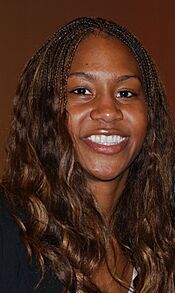
Paul Westhead left the Mercury after their 2007 win, and the team struggled in 2008. The Detroit Shock, however, won their third championship under coach Bill Laimbeer. Laimbeer resigned in 2009, ending the Shock's dominant period.
In 2008, the first outdoor professional basketball game in North America was played in New York City. The Indiana Fever beat the New York Liberty in front of over 19,000 fans.
The Houston Comets, one of the league's original teams, closed down in December 2008 because no new owners could be found.
In 2009, the Phoenix Mercury, with new coach Corey Gaines and the return of Penny Taylor, again played a fast-paced game. They won their second WNBA championship, beating the Indiana Fever in a thrilling five-game series.
Changes and New Stars (2010–2012)
In October 2009, the Detroit Shock moved to Tulsa, Oklahoma, and became the Tulsa Shock. In November 2009, the Sacramento Monarchs also closed down.
The 2010 season saw new teams in the Finals: the Seattle Storm and the Atlanta Dream. Seattle won their first championship since 2004.
After the 2010 season, President Orender resigned. Laurel J. Richie became the new president in May 2011.
The 2011 WNBA season started with a lot of excitement because of new young stars joining the league. Many news outlets started covering the WNBA more often. The league saw higher attendance, and new players like Candace Parker, Maya Moore, DeWanna Bonner, Angel McCoughtry, Sylvia Fowles, Tina Charles, and Liz Cambage brought a lot of energy to the game.
In 2011, Tina Charles set a record for double-doubles in a season. Sylvia Fowles became only the second player to average at least 20 points and 10 rebounds per game. Angel McCoughtry led her team to the 2011 Finals for the second year in a row, but the Dream were swept by the Minnesota Lynx, who won their first title.
The 2012 WNBA season had a long break for the Olympics. The Indiana Fever won the WNBA championship that year.
The "Three to See" and More Relocations (2013–2019)
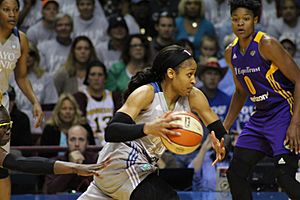
The 2013 WNBA draft was very popular because of three top college stars: Brittney Griner, Elena Delle Donne, and Skylar Diggins. They were called "The Three To See." This draft, along with new rule changes and the retirement of legends like Katie Smith and Tina Thompson, marked a new era for the WNBA.
The Minnesota Lynx won their second title in three years in the 2013 Finals. The popularity of the new players helped boost TV ratings for the league by 28 percent.
More teams moved in the following years. The Tulsa Shock moved to Dallas–Fort Worth in Texas in 2016 and became the Dallas Wings. In 2018, the San Antonio Stars moved to Nevada and became the Las Vegas Aces.
New Player Agreement and Commissioner's Cup (2020)
In January 2020, the WNBA and its players agreed on a new collective bargaining agreement (CBA) that would last until 2027. This new agreement brought many improvements for players:
- Players' total pay increased by more than 50%.
- Players could become free agents (meaning they could sign with any team) sooner.
- Players would travel in premium economy class for flights and get their own hotel rooms on road trips.
- Players would receive full pay during maternity leave, plus a $5,000 yearly childcare payment. Teams would also provide larger apartments for players with children and facilities for nursing mothers.
- Veteran players who missed the start of training camp would be penalized.
- Veteran players could work as coaches in the NBA without salary limits.
Also in January 2020, the WNBA announced a new tournament called the Commissioner's Cup. Teams would play 10 Cup games during the regular season, and the top team from each conference would play in a final game in August.
The 2020 WNBA season was delayed due to the COVID-19 pandemic. The draft still happened online. The Commissioner's Cup was not held in 2020.
2020 Season at IMG Academy
In June 2020, the WNBA announced that the 2020 season would be shorter (22 games) and played entirely at IMG Academy in Bradenton, Florida. Players lived at the complex, and all games and practices took place there to keep everyone safe.
"Count It" Campaign and Expansion (2021–Present)
On March 15, 2021, the WNBA launched its "Count It" campaign to celebrate its 25th anniversary. As part of this, they revealed The W25, a list of the 25 greatest and most influential players in the league's history.
The Commissioner's Cup officially launched in 2021. The Cup final was held on August 12, 2021, and was streamed on Amazon Prime Video. The winning team received a prize pool of $500,000.
In February 2022, the league raised $75 million, which valued the WNBA at $475 million. The league's commissioner, Cathy Engelbert, said in mid-2022 that the WNBA hoped to add one or two new teams by the end of the year, possibly starting play in 2024.
On September 26, 2023, it was reported that the owners of the Golden State Warriors were planning to start an expansion team in San Francisco. This was officially announced on October 5, 2023. The Golden State Valkyries began playing in 2025 at the Chase Center. This was the first new WNBA team since the Atlanta Dream in 2008.
On May 23, 2024, it was announced that a new team based in Toronto would debut in 2026. On September 18, 2024, a new Portland expansion team was also officially announced to debut in 2026.
On June 30, 2025, the WNBA announced expansion teams in Cleveland, Detroit, and Philadelphia. The Cleveland team is scheduled to begin play in 2028, Detroit in 2029, and Philadelphia in 2030.
WNBA Teams
The WNBA started with 8 teams in 1997. Through new teams joining, some teams closing, and others moving, the league has 13 teams as of the 2025 season. In total, 19 different teams have been part of the WNBA's history.
As of the 2025 season, the Las Vegas Aces (which used to be the Utah Starzz and San Antonio (Silver) Stars), Los Angeles Sparks, New York Liberty, and Phoenix Mercury are the only original teams from 1997 that are still playing.
The arenas listed below are those used during the 2025 season.
| Symbol | Meaning |
|---|---|
| * | Franchise has relocated at some point in its existence |
| Conference | Team | City | Arena | Capacity | Joined | Head coach |
|---|---|---|---|---|---|---|
| Eastern | Atlanta Dream | College Park, Georgia | Gateway Center Arena | 3,265 | 2008 | Karl Smesko |
| Chicago Sky | Chicago, Illinois | Wintrust Arena | 10,387 | 2006 | Tyler Marsh | |
| Connecticut Sun | Uncasville, Connecticut | Mohegan Sun Arena | 8,910 | 1999* | Rachid Meziane | |
| Indiana Fever | Indianapolis, Indiana | Gainbridge Fieldhouse | 17,274 | 2000 | Stephanie White | |
| New York Liberty | Brooklyn, New York | Barclays Center | 17,732 | 1997 | Sandy Brondello | |
| Washington Mystics | Washington, D.C. | CareFirst Arena | 4,200 | 1998 | Sydney Johnson | |
| Western | Dallas Wings | Arlington, Texas | College Park Center | 6,251 | 1998* | Chris Koclanes |
| Golden State Valkyries | San Francisco, California | Chase Center | 18,064 | 2025 | Natalie Nakase | |
| Las Vegas Aces | Paradise, Nevada | Michelob Ultra Arena | 10,509 | 1997* | Becky Hammon | |
| Los Angeles Sparks | Los Angeles, California | Crypto.com Arena | 18,997 | 1997 | Lynne Roberts | |
| Minnesota Lynx | Minneapolis, Minnesota | Target Center | 19,356 | 1999 | Cheryl Reeve | |
| Phoenix Mercury | Phoenix, Arizona | PHX Arena | 18,422 | 1997 | Nate Tibbetts | |
| Seattle Storm | Seattle, Washington | Climate Pledge Arena | 18,100 | 2000 | Noelle Quinn |
Future WNBA Teams
The WNBA has plans for more teams to join the league in the coming years.
| Team | City | Arena | Capacity | Joining |
|---|---|---|---|---|
| Portland Fire | Portland, Oregon | Moda Center | 19,393 | 2026 |
| Toronto Tempo | Toronto, Ontario | Coca-Cola Coliseum | 8,700 | 2026 |
| Cleveland WNBA team | Cleveland, Ohio | Rocket Arena | 19,432 | 2028 |
| Detroit WNBA team | Detroit, Michigan | Little Caesars Arena | 20,332 | 2029 |
| Philadelphia WNBA team | Philadelphia, Pennsylvania | Xfinity Mobile Arena | 21,000 | 2030 |
WNBA Teams and NBA Teams
Some WNBA teams are connected to NBA teams in the same city. These are called "sister teams." For example, the New York Liberty and Brooklyn Nets are sister teams. The Golden State Valkyries and Golden State Warriors are also sister teams.
Other WNBA teams are in the same city as an NBA team but are owned separately. For instance, the Chicago Sky and Chicago Bulls are both in Chicago, but they have different owners.
A few WNBA teams are not in the same city as an NBA team at all. The Connecticut Sun is one example, as it is owned by a casino. The Seattle Storm used to be connected to the Seattle SuperSonics, but when the SuperSonics moved, the Storm got new owners.
How the Season Works
Regular Season Games
Teams start with training camps in May to get ready for the season and choose their 12 players. After that, they play some practice games.
The WNBA regular season starts in May. In 2025, each team plays 44 games, with half at home and half away. Just like in the NBA, every team plays against every other team at least once.
In years when the Summer Olympics happen, the WNBA takes a month-long break so players can join their national teams.
The Commissioner's Cup
The Commissioner's Cup is a special tournament played during the regular season. In 2024, each team played one Cup game against every team in its conference. These games happened in the first half of June. The top team from each conference then played in the Commissioner's Cup Final in late June or early July. All Cup games, except the final, also count as regular-season games.
All-Star Game Fun
The first WNBA All-Star Game was held in 1999. It's a special event where the best players from the league play against each other. Since 2018, players are chosen for the All-Star Game without worrying about which conference they are from. Fans, players, and sports media vote for the starters. The two players with the most fan votes become team captains and pick their teams.
The All-Star Game is part of a weekend event held in a different WNBA city each year. In 2021 and 2024, the All-Star Game featured a WNBA all-star team playing against the U.S. national team.
After the All-Star break, there's a "trading deadline." After this date, teams can't trade players with each other for the rest of the season, but they can still sign or release players.
Playoffs and Finals
The WNBA Playoffs usually start in late September. The eight best teams from the regular season, regardless of their conference, make it to the playoffs. Since 2022, the playoffs have a standard knockout format. The first round is a best-of-three series, and the semifinals and finals are best-of-five.
Having a higher seed (meaning a better regular-season record) gives a team advantages, like playing against a weaker team and having "home-court advantage" (playing more games at their home arena).
The final playoff round is called the WNBA Finals. It's a best-of-five series between the two semifinal winners and is usually played in October. The winning team's players get a championship ring. The league also gives out a WNBA Finals Most Valuable Player Award to the best player in the Finals.
Players and Coaches
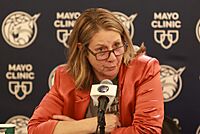
In 2011, only two players from the WNBA's first season in 1997 were still playing: Sheryl Swoopes and Tina Thompson. Lisa Leslie played her entire career (1997–2009) with the Los Angeles Sparks. Sue Bird holds the record for playing the most seasons (19) and most games (580) in the league.
The WNBA has honored its best players over the years with special teams: the WNBA's All-Decade Team (2006), the WNBA's Top 15 Team (2011), the WNBA Top 20@20 (2016), and The W25 (2021).
Over 30 players have scored at least 3,000 points in their WNBA careers. Only 14 players have reached 6,000 points, including Diana Taurasi, Tina Thompson, and Tamika Catchings. The player with the highest scoring average is Cynthia Cooper, who averaged 21.0 points per game.
In 2007, Paul Westhead became the first person to win championships as a coach in both the NBA and the WNBA.
In 2008, 50-year-old Nancy Lieberman became the oldest player to play in a WNBA game. She broke her own record from 1997 when she was 39. The oldest player to play a full season is Diana Taurasi, who was 42 during the 2024 season.
Sue Bird holds the record for most career assists with 3,234. Courtney Vandersloot holds the record for most assists per game, averaging 6.64.
Player Milestones
| Milestone | Player | Team | Date | Information |
|---|---|---|---|---|
| First player signed | Sheryl Swoopes | Houston Comets | October 23, 1996 | Signed by the WNBA and assigned to Houston. |
| First points scored | Penny Toler | Los Angeles Sparks | June 21, 1997 | Scored the first points on a baseline jump-shot. |
| First triple-double | Sheryl Swoopes | Houston Comets | July 27, 1998 | 14 points, 15 rebounds, 10 assists |
| First slam dunk | Lisa Leslie | Los Angeles Sparks | July 30, 2002 | Dunked on a fast break against Miami |
| First 50–40–90 season | Elena Delle Donne | Washington Mystics | 2019 | 51.5% FG, 43.0% 3FG, 97.4% FT |
| Most games played | Sue Bird | Seattle Storm | 2002–2012, 2014–2018, 2020–2022 | 580 games |
| Most career points | Diana Taurasi | Phoenix Mercury | 2004–2014, 2016–2024 | 10,646 points |
| Most career rebounds | Tina Charles | Connecticut Sun / Washington Mystics / Phoenix Mercury / Seattle Storm / Atlanta Dream | 2010–2019, 2021–2022, 2024–present | 4,014 rebounds |
| Most career assists | Sue Bird | Seattle Storm | 2002–2012, 2014–2018, 2020–2022 | 3,234 assists |
| Most career blocks | Margo Dydek | Utah Starzz / San Antonio Silver Stars / Connecticut Sun / Los Angeles Sparks | 1998–2004, 2005–2007, 2008 | 877 blocks |
| Most career steals | Tamika Catchings | Indiana Fever | 2002–2016 | 1,074 steals |
| Most 3-pointers | Diana Taurasi | Phoenix Mercury | 2004–2014, 2016–2024 | 1,447 3-pointers |
| Most points in a game | Liz Cambage | Dallas Wings | July 17, 2018 | 53 points |
| A'ja Wilson | Las Vegas Aces | August 22, 2023 | ||
| Most rebounds in a game | Chamique Holdsclaw | Washington Mystics | May 23, 2003 | 24 rebounds |
| Most assists in a game | Caitlin Clark | Indiana Fever | July 17, 2024 | 19 assists |
| Most career wins for a coach | Mike Thibault | Connecticut Sun / Washington Mystics | 2003–2022 | 379 wins |
| Most team points in one game | – | Phoenix Mercury | July 24, 2010 | 127 points in double overtime against Minnesota |
| Most team points in a regulation game | – | Phoenix Mercury | July 22, 2010 | 123 points against Tulsa |
| Largest margin of victory | – | Minnesota Lynx | August 18, 2017 | 59-point win (111–52) over Indiana |
| Largest attendance for any game | – | Detroit Shock | September 16, 2007 | 22,076 in game 5 of 2007 Finals |
| Largest attendance for a regular-season game | – | Washington Mystics | September 19, 2024 | 20,711 vs. Indiana Fever |
Awards for Players and Coaches
At the end of the regular season, various awards are given out.
- The Most Valuable Player Award goes to the player who was most important to her team.
- The Rookie of the Year Award is for the best first-year player.
- The Most Improved Player Award is for the player who showed the most improvement.
- The Defensive Player of the Year Award is for the best defender.
- The Sixth Player of the Year Award is for the best player who usually comes off the bench.
- The Kim Perrot Sportsmanship Award is for a player who shows great sportsmanship.
- The Coach of the Year Award is for the coach who made the biggest positive difference for their team.
- The Basketball Executive of the Year Award is for the team executive who helped their team succeed the most.
- The Community Assist Award is for a player who does great community service.
There are also All-WNBA Teams, All-Defensive Teams, and an All-Rookie Team, which recognize the top players in different categories.
Recent Award Winners (2024 Season)
| Award | Winner | Position | Team | Votes/Statistic | |
|---|---|---|---|---|---|
| Most Valuable Player Award | A'ja Wilson | Forward | Las Vegas Aces | 67 out of 67 | |
| Finals MVP Award | Jonquel Jones | Forward | New York Liberty | N/A | |
| Rookie of the Year Award | Caitlin Clark | Point guard | Indiana Fever | 66 out of 67 | |
| Most Improved Player Award | DiJonai Carrington | Guard-forward | Connecticut Sun | 28 out of 67 | |
| Defensive Player of the Year Award | Napheesa Collier | Forward | Minnesota Lynx | 36 out of 67 | |
| Sixth Player of the Year Award | Tiffany Hayes | Guard | Las Vegas Aces | 38 out of 67 | |
| Kim Perrot Sportsmanship Award | Dearica Hamby | Forward | Los Angeles Sparks | 12 out of 67 | |
| Peak Performer: Points | A'ja Wilson | Forward | Las Vegas Aces | 26.9 PPG | |
| Peak Performer: Rebounds | Angel Reese | Forward | Chicago Sky | 13.1 RPG | |
| Peak Performer: Assists | Caitlin Clark | Guard | Indiana Fever | 8.4 APG | |
| Coach of the Year Award | Cheryl Reeve | Coach | Minnesota Lynx | 62 out of 67 | |
| Basketball Executive of the Year Award | Cheryl Reeve | President of Basketball Operations | Minnesota Lynx | 10 out of 36 | |
| Community Assist Award | Brittney Griner (2023) | Center | Phoenix Mercury | N/A | |
Retired Jersey Numbers
Some WNBA teams honor their most important players by retiring their jersey numbers. This means no other player on that team can wear that number again.
| No. | Team | Player | Pos. | Tenure | Ref. |
|---|---|---|---|---|---|
| 3 | Los Angeles Sparks | Candace Parker | F | 2008-2020 | |
| 9 | Lisa Leslie | C | 1997–2009 | ||
| 11 | Penny Toler | G | 1997–1999 | ||
| 24 | Indiana Fever | Tamika Catchings | SF | 2002–2016 | |
| 25 | Las Vegas Aces | Becky Hammon | G | 2007–2014 | |
| 13 | Minnesota Lynx | Lindsay Whalen | G | 2010–2018 | |
| 23 | Maya Moore | F | 2011–2018 | ||
| 32 | Rebekkah Brunson | F | 2010-2018 | ||
| 33 | Seimone Augustus | G | 2006-2019 | ||
| 34 | Sylvia Fowles | C | 2015-2022 | ||
| 7 | Phoenix Mercury | Michele Timms | G | 1997–2001 | |
| 13 | Penny Taylor | G/F | 2004–2016 | ||
| 22 | Jennifer Gillom | F | 1997–2002 | ||
| 32 | Bridget Pettis | G | 1997–2006 | ||
| 15 | Seattle Storm | Lauren Jackson | F/C | 2001–2012 | |
| 10 | Sue Bird | G | 2001–2022 |
- Pending number retirements
| No. | Team | Player | Pos. | Tenure | Date | Ref. |
|---|---|---|---|---|---|---|
| 3 | Chicago Sky | Candace Parker | F | 2021–2022 | August 25, 2025 |
International Players in the WNBA
Many talented players from around the world have played in the WNBA. Some have won awards or been named All-Stars, like Lauren Jackson from Australia, who won MVP three times, and Jonquel Jones from The Bahamas, who won MVP in 2021.
Rules of the Game
The WNBA follows most standard basketball rules from the NBA, but with a few differences:
- The three-point line is a bit closer than in the NBA.
- The WNBA uses a slightly smaller and lighter basketball than the NBA. This size is used for all major women's basketball games worldwide.
- Games are divided into four 10-minute quarters, not two 20-minute halves.
Since 2006, many WNBA rules have been changed to match NBA rules more closely. For example, the shot clock was changed from 30 to 24 seconds.
In 2012, the WNBA added a "block/charge arc" under the basket. In 2013, they added the defensive three-second rule and rules against "flopping" (when a player fakes being fouled).
Court Size
| WNBA Court Dimensions | ||
|---|---|---|
| Area | Imperial | Metric |
| Length of court (baseline to baseline) | 94 ft | 28.65 m |
| Width of court (sideline to sideline) | 50 ft | 15.24 m |
| Rim height (floor to rim) | 10 ft | 3.05 m |
| Center circle diameter | 12 ft | 3.66 m |
| Three-point line distance from center of basket | 22 ft 1.75 in | 6.75 m |
| Three-point line distance from center of basket (corners) | 22 ft | 6.71 m |
| Shaded area/Lane/Key length | 19 ft | 5.8 m |
| Shaded area/Lane/Key width | 16 ft | 4.88 m |
| Restricted area (aka "block/charge arc") (distance from center of basket) |
4 ft | 1.22 m |
| Free-throw line (distance from backboard) | 15 ft | 4.57 m |
| Free-throw half-circle radius | 6 ft | 1.83 m |
| Backboard width (side to side) | 6 ft | 1.83 m |
| Coaching box width (from baseline) | 28 ft | 8.54 m |
| *Most dimensions are similar to NBA rules, except for the main three-point arc. The three-point distance at the corners is the same in both leagues. | ||
Business of the WNBA
Money and Growth
For many years, the NBA helped the WNBA financially. In 2010, the WNBA had its first team that made a profit. By 2013, six of the 12 teams were making a profit.
By 2024, the WNBA's income grew quickly from new investments, media deals, expansion fees, ticket sales, and sponsorships. However, about 40% of the money goes to the teams and players, with the rest going to the NBA and other investors.
Players and Social Causes
The WNBA is known for its players speaking out on important social issues. They often talk about fairness between men's and women's sports, and about equality for different genders, sexual orientations, and races. Players like Brittney Griner, Breanna Stewart, and Maya Moore have been very vocal.
The players have also supported movements like Black Lives Matter. For example, the Minnesota Lynx players wore special T-shirts to support justice and accountability. In 2020, the league and players decided to put Black Lives Matter and "Say Her Name" slogans on their warm-up gear. When a team owner criticized this, her team wore T-shirts supporting her election opponent.
During the COVID-19 pandemic, WNBA teams helped promote the COVID-19 vaccine. They hosted vaccine clinics and made public service announcements. By June 2021, 99% of WNBA players were fully vaccinated.
A documentary film called Power of the Dream was released in June 2024. It focuses on the league's support for Black Lives Matter and political action.
Sponsorships and Uniforms
On June 1, 2009, the Phoenix Mercury was the first WNBA team to have a sponsor's logo on their jerseys. Other teams soon followed, with sponsors appearing on jerseys and warm-ups.
In 2011, Boost Mobile became a league-wide sponsor, putting its logo on most team jerseys. The league's uniform supplier, Adidas, also updated all team uniforms with new designs.
In April 2019, AT&T became a major partner, with its logo featured on the front of all 12 team jerseys. In 2020, the league started "WNBA Changemakers," a group of businesses that invest in and promote women's sports.
Player Salaries and Team Rosters
Before the 2009 season, the maximum team roster size was changed from 13 to 11 players. In March 2014, a new agreement increased the roster size to 12 players.
The WNBA draft happens every spring. Players must be at least 22 years old (or 20 for international players). The draft has three rounds.
The current player agreement, which started in 2020, significantly increased player salaries. The minimum salary for a rookie in 2020 was $35,190, while the maximum for experienced players was $185,000 (or $215,000 for top players). Many WNBA players also play in overseas leagues during the offseason to earn more money.
Players get bonuses for achievements like winning the WNBA championship ($11,356 per player) or being named MVP ($15,450).
A challenge for the league is that there are not enough roster spots for all the talented new players. This means many drafted players don't make a team. The WNBA also doesn't have a minor league like the NBA does.
A rule called "prioritization" in the 2020 agreement means that veteran players who miss the start of training camp (often because they are playing overseas) can be fined or even suspended without pay. This rule encourages players to focus on the WNBA season.
Player Earnings
WNBA players earn less than NBA players, mainly because the WNBA generates less money. However, players have pointed out that they receive a smaller percentage of the league's revenue compared to NBA players.
Audience and Viewership
The WNBA's audience has grown a lot. In 2023, the league and teams together brought in an estimated $180 million to $200 million in revenue.
The WNBA's viewership increased by 67% halfway through the 2023 season, with an average of 556,184 viewers per game. Their social media presence also grew, with over 24 million views across platforms. In May 2024, Commissioner Cathy Engelbert announced that the league would spend $50 million over two years to fund charter flights for players.
Player Marketing Agreements
Player marketing agreements (PMAs) are contracts that allow WNBA players to earn more money by promoting the WNBA year-round. As of 2022, 10 players had signed PMAs. These agreements help players earn more during the offseason and encourage them to stay with the WNBA instead of playing overseas.
NBA Support
The NBA partly owns the WNBA and provides between $10-$15 million annually to support the league. Six WNBA teams are "sister teams" to NBA teams in the same areas. The WNBA earns less from sponsorships and TV deals than the NBA. For example, the WNBA gets $25 million from ESPN, while the NBA gets $930 million from ESPN and TNT.
In July 2024, the WNBA negotiated a new media rights deal as part of a larger package with the NBA worth $77 billion. Under this new deal, the WNBA expects to earn $200 million a year for the next eleven years, a big increase from previous years.
Merchandise Sales
The WNBA sells a lot of merchandise, especially jerseys. The arrival of Caitlin Clark in 2024 led to a huge increase in public interest and record merchandise sales.
Top Jersey Sales (First Half of 2025)
| Jersey Sales | ||||||||||
|---|---|---|---|---|---|---|---|---|---|---|
| Rank | 1 | 2 | 3 | 4 | 5 | 6 | 7 | 8 | 9 | 10 |
| Player | Caitlin Clark | Paige Bueckers | Kate Martin | Angel Reese | A'ja Wilson | Hailey Van Lith | Cameron Brink | Napheesa Collier | Kamilla Cardoso | Sabrina Ionescu |
| Team | Fever | Wings | Valkyries | Sky | Aces | Mercury | Sparks | Lynx | Sky | Liberty |
League Leaders: Presidents and Commissioners
The head of the WNBA used to be called "President." Cathy Engelbert became the first "Commissioner" in 2019.
- Val Ackerman, 1996–2005
- Donna Orender, 2005–2010
- Chris Granger, 2011 (interim)
- Laurel J. Richie, 2011–2015
- Lisa Borders, 2015–2018
- Mark Tatum, 2018–2019 (interim)
- Cathy Engelbert, 2019–present
Attendance at Games
In the WNBA's first season in 1997, the average attendance per game was 9,661 fans. Attendance grew in 1998 but then slowly dropped until 2006. From 2007 to 2014, attendance stayed about the same.
In 2015, attendance reached a record low of 7,318 fans per game. This was partly due to teams moving to smaller arenas. Attendance recovered slightly in 2016 and 2017 but dropped again in 2018 and 2019. This was also partly because some teams moved from very large arenas to smaller ones.
The 2020 season was played without fans due to the COVID-19 pandemic. In 2021, attendance was still low, but by 2022 and 2023, it started to recover to pre-pandemic levels.
The 2024 WNBA regular season was a huge success for attendance, with an average of 9,807 fans per game, a 48% increase from 2023. Three games had over 20,000 fans, including a record 20,711 fans when the Indiana Fever played the Washington Mystics. This surge in interest was largely due to the excitement around the 2024 rookie class, especially top draft pick Caitlin Clark.
Media Coverage
WNBA games are shown on TV in the U.S. on ABC, ESPN, ESPN2, Ion Television, NBATV, CBS, and CBS Sports Network.
In the early years, networks like Lifetime and Oxygen also showed games. NBC broadcast games until 2002, when the rights moved to ABC/ESPN.
In 2007, the WNBA signed a deal with ESPN, which was the first time a women's professional league was paid for its TV rights. This deal meant at least 18 games would be shown each season. In 2013, a new deal with ESPN meant 30 games would be shown each season, and each team would receive about $1 million per year.
In April 2019, CBS Sports Network started showing 40 regular-season WNBA games. In April 2023, Ion Television also signed a deal to show WNBA games on Friday nights.
Starting in 2026, WNBA games will also be shown on NBC Sports, in addition to ESPN/ABC and Amazon Prime Video. This new deal will bring more than 125 games to national and worldwide audiences.
Some teams also have games on local radio or TV stations.
- Atlanta – WPCH-TV
- Chicago – WCIU-TV
- Connecticut – NBC Sports Boston, New England Cable News, Peacock
- Dallas – WFAA, KFAA-TV
- Indiana – WTHR, WALV
- Golden State – KPIX-TV, KPYX
- Las Vegas – KMCC
- Los Angeles – Spectrum SportsNet
- Minnesota – FanDuel Sports Network North
- New York – WNYW, WWOR
- Phoenix – KTVK, KPHE
- Seattle – KOMO-TV, KUNS
- Washington – Monumental Sports Network
WNBA League Pass
In 2009, the WNBA launched "WNBA LiveAccess" (now called WNBA League Pass). This online service lets fans watch live games throughout the season. Most games are available, except for those shown on ABC, ESPN, or ESPN2. You can subscribe to WNBA League Pass for $16.99 per season.
Images for kids
-
Lauren Jackson, one of the most notable players in WNBA history.
-
Diana Taurasi of the Mercury
See also
 In Spanish: Women's National Basketball Association para niños
In Spanish: Women's National Basketball Association para niños


